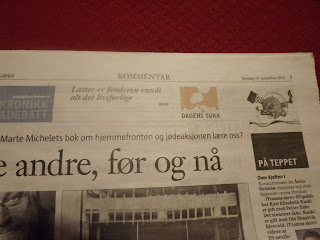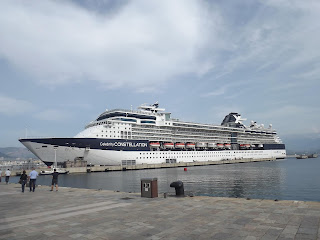AN OLD AND
FORGOTTEN HISTORICAL MOVIE: THE BATTLE OF SUTJESKA- MISSING FACTS, FICTION AND
REALITY
THE AIM
Historical
movies dealing with both fiction and reality about events reported in books and
papers have paid my attentions for some years. Recently I bought an interesting
book about movies made in Hollywood. The
aim of the book is to reveal what was the facts about the events described in
the movies and what was fiction only. The title of the book is: “ Hollywood
historier. Virkelighetens Hollywood. De sanne historiene bak storfilmene.” (Eng.title: The stories of Hollywood. The
true story of Hollywood and the true story of the great movies).
THE BATTLE
OF SUTJESKA or THE FIFTH OFFENSIVE
The
research work to be done was to view the film again and again making notes of
different actors, events, use of aircrafts and making a description of the
content. The story of the film is the story of the famous battle of Sutjeska in
Yugoslavia during the Second World War. The Yugoslav Partisans are chaired by
Marshal Josip Broz Tito. The Axis are chaired by General Alexander Løhr
(1885-1947) and General Rudolf Luters.
The role of
General Alexander Løhr is played by Anton Diffring and General Rudolf Luters is
played by Gunter Meisner. Josip Broz
Titio is played by Richard Burton.
BACKGROUNG
HISTORY
In 1941
Yugoslavia was invaded by the Axis. King Peter II went in exile to England
where he sat up a government. In Yugoslavia the resistance against the Axis was
organized by the royalist Draza Mihailovic and also by groups supported by the
communist party of Yugoslavia. Josip Broz Tito was the commander of the
communist resistance movement. He was a professional communist revolutionary
who had taken part in the Spanish Civil War. Winston S. Churchill was an anti
communist all his life but he evaluated the standard of the military forces
with reference to the fighting ability of the soldiers. Therefore he decided to
support Marshal Tito in his fight in Yugoslavia.
OPERATION
TYPICAL
Special
Operative Executive(SOE)
The movie
is dealing with the British military operation called “ Operation Typical “.
The operation was launched in may 1943. The British General Headquarters in the
Middle East was responsible for the support to the Partisans. The movie does
not give you a correct description of the British military support to Tito. In
the movie only four British soldiers are parachuted. The names of the soldiers
are not correct either. The official report of the mission makes it clear that
six soldiers are parachuted- not only four. The mission is important because it
is the first British assigned to Yugoslav Partisans HQ and to Marshal Tito. The
British soldiers were departed on May 27, 1943 from Derna in Libya and arrived
at Crno Jezero in Montenegro . The names of the soldiers were: Col. William
Deakin, Capt. William F. Stuart, Sgt. Walter Wroughton , Sgt. Peretz ‘ Rose’
Rosenberg, Canadian- Yugoslav Ivan (John) Starcevic and Sgt. John Campbell.
The names
of the British soldiers in the movie are:
-Captain
Stewart, Captain Dicken, Sgt. Throten and Sgt. Roys.
What
happened to the British soldiers? Captain William F. Stuart was killed and
Captain William Deakin was wounded after a German air attack. Marshal Tito was
also wounded the same day when German aircrafts attacked the Partisans.
BRITISH
MILITARY MISSIONS IN YUGOSLAVIA
The SOE
launched about 22 military missions to Yugoslavia during the war. Even Randolph
Churchill -the son of Winston S. Churchill- took part in the fighting in
Yugoslavia. Apart from three missions most of the missions were launched by
airborne. Submarines were used only three times.
THE BATTLE
OF SUTSJESKA
The content
of the movie is the dramatic fighting between the Partisans and the Axis. The
German generals wanted to destroy the Partisans once and for all. The fighting
is described in a very realist way. We believe in the story. The policy of the
German generals was the killing of Partisans, all people who supported the
resistance movement- children, men, women – all should be killed.The Axis
rallied about 127.000 troops for the offensive including German, Italian,
Independent State of Croatia and Bulgarian soldiers. About 300 airplanes
were used. The Yugoslav National Libration Army had about 22.148 soldiers in 16
brigades. The offensive lasted from May 15 to June 16, 1943.
The German
offensive was a failure. The Axis did not an end to the fight of the Partisans.
The guerrilla fighting went on till the end of the war.
THE GERMAN
AIRCRAFTS USED N THE MOVIE
The
Partisans are attacked by German aircrafts many times. The aircrafts which are
dropping bombs on the camps of the Partisans are not correct German aircrafts.The aircraft used is named, SOKO 522. The aircraft was made in Yugoslavia in 1955. A military trainer and light attack aircraft which has been used in different movies .The
aircrafts used for observation and to transport of officers are correct German
aircrafts. The name of the aircraft is FIESELER Fi 156 STORCH. A German liason aircraft.
THE
DESCRIPTION OF MARSHAL TITO
Richard
Burton is playing the role of Marshal Tito. We do not get much information
about Tito during the battle. No information of his political background,
education, family, or his private life. No.
CONCULSION
The film
gives you a description of the fighting in a true way. We believe in the story.
A closer picture of Tito is missing and also a closer picture of the German
generals who chaired the battle is missing. About 2537 pro-Partisan civilians
were executed by the Axis. The Partisans lost about 7543 soldiers in the
battle. The total casualities of Axis were about 913 killed, 2467 wounded and
2132 missing .The Serbian National Library in Belgrade was also destroyed
during the fight against the Partisans.
Photo from the movie: Actor Gunter Meisner(1926 - 1994) as General Rudolf Luters.



















































